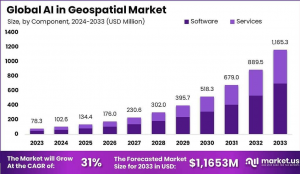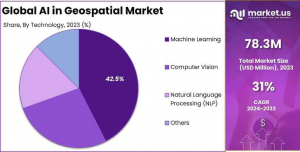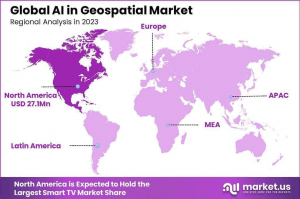The Global AI in Geospatial Market is set to an impressive USD 1,165.3 Mn by 2033, growing at a remarkable 31.0% CAGR.
Transportation and Logistics segment held a prominent position, capturing more than 25% of the market share. ”
NEW YORK, NY, UNITED STATES, January 24, 2025 /EINPresswire.com/ -- As per the report from Market.us, The AI in geospatial Market is growing rapidly, driven by the increasing availability of geospatial data and advancements in AI technology. Businesses and governments are recognizing the potential of AI-powered geospatial analytics to provide deeper insights into resource management, infrastructure development, and environmental monitoring. This market encompasses a range of applications, including satellite imagery analysis, location-based services, and geographic information systems (GIS), catering to industries such as defense, agriculture, and retail.— Tajammul Pangarkar
The primary drivers of the AI in geospatial market include the surge in demand for predictive analytics and the need for more efficient data processing methods in the geospatial field. As the volume of spatial data from sources like drones, satellites, and IoT devices grows, the necessity for AI to handle, analyze, and interpret this data becomes more critical. Additionally, the increasing adoption of cloud-based solutions and advancements in computing power are enabling more organizations to leverage AI in their geospatial applications.
👉 𝐂𝐥𝐢𝐜𝐤 𝐭𝐨 𝐑𝐞𝐪𝐮𝐞𝐬𝐭 𝐒𝐚𝐦𝐩𝐥𝐞 𝐑𝐞𝐩𝐨𝐫𝐭 𝐚𝐧𝐝 𝐃𝐫𝐢𝐯𝐞 𝐈𝐦𝐩𝐚𝐜𝐭𝐟𝐮𝐥 𝐃𝐞𝐜𝐢𝐬𝐢𝐨𝐧𝐬: https://market.us/report/ai-in-geospatial-market/free-sample/
Currently, the AI in geospatial market is witnessing trends such as the growing use of AI for disaster response and climate monitoring, which require rapid analysis of environmental changes. There's also a significant push towards the automation of map-making and spatial data visualization, which enhances the usability of geospatial insights in real-time decision-making. Moreover, collaboration between AI technology providers and geospatial data companies is on the rise, aiming to integrate varied data sources and improve analytics capabilities.
Stakeholders in the AI in geospatial market, including technology providers, end-users, and investors, benefit from several key aspects. For technology providers, there is a vast opportunity to innovate and capture new markets, especially in regions that are just beginning to adopt geospatial technologies. End-users, such as government bodies and businesses, gain from more accurate and timely insights for planning and operations, potentially saving costs and increasing efficiency.
Key Highlights:
In 2023, the software segment dominated the market, accounting for over 60% of the total share. This highlights the strong demand for AI-powered software solutions in geospatial applications, from mapping to predictive analytics.
Technologies like machine learning secured more than 42.5% of the market share in 2023. This indicates its growing use in improving geospatial data analysis, helping industries make smarter, data-driven decisions.
Among applications, the transportation and logistics sector emerged as a key player, holding over 25% of the market share. Businesses in this space increasingly rely on AI-enhanced geospatial tools to optimize routing, streamline supply chains, and improve efficiency.
In 2023, North America stood out as the largest regional market, capturing more than 34.5% of the global share and generating approximately USD 27.1 million in revenue. The region's leadership is fueled by advanced technology adoption and substantial investments in AI and geospatial systems.
According to gov.uk, the government has invested more than £3.5 billion in AI over the course of the last decade to help realise the Geospatial technology’s transformative potential across the economy.
Analysts’ Viewpoint on AI in the Geospatial Market
Investment Opportunities and Risks in AI Geospatial Market
In the AI geospatial market, significant investment opportunities are emerging as technologies like machine learning and large language models enhance data accessibility and usability. These innovations are streamlining complex tasks such as automatic feature extraction and data validation, opening new avenues for industry applications. However, the rapid evolution of AI also introduces risks, primarily related to data security and intellectual property protection, necessitating careful integration and management of AI tools to safeguard investments and ensure reliable outcomes.
Technological Impact and Regulatory Environment
The technological impact of AI on the geospatial sector is substantial, enabling more efficient processing and analysis of extensive datasets, which enhances decision-making processes across multiple industries. Simultaneously, the regulatory landscape is adapting, with an emphasis on ensuring compliance with data protection laws and managing cybersecurity risks. In the U.S., the regulatory framework is expected to remain relatively lenient at the federal level, though state regulations may present stricter challenges, influencing how AI technologies are implemented and controlled.
👉 𝐁𝐮𝐲 𝐍𝐨𝐰 𝐭𝐡𝐢𝐬 𝐏𝐫𝐞𝐦𝐢𝐮𝐦 𝐑𝐞𝐩𝐨𝐫𝐭 𝐭𝐨 𝐆𝐫𝐨𝐰 𝐲𝐨𝐮𝐫 𝐁𝐮𝐬𝐢𝐧𝐞𝐬𝐬: https://market.us/purchase-report/?report_id=125051
Report Segmentation
Component Analysis
In 2023, the Software segment held a dominant position in the AI in Geospatial Market, accounting for over 60% of the total market share. This dominance can be attributed to the increasing adoption of AI-powered geospatial software solutions across industries for tasks such as mapping, predictive analytics, image recognition, and real-time data processing.
Advanced geospatial software platforms leveraging machine learning and computer vision are streamlining workflows, enabling automation, and delivering actionable insights to end-users. Key players are continuously enhancing software capabilities with cloud integration, real-time analytics, and improved visualization tools, further driving adoption. The growing demand for geospatial APIs and software development kits (SDKs) to enable custom AI applications has also contributed significantly to the segment’s growth.
The Services segment, while smaller in comparison, is witnessing steady growth due to rising demand for implementation, consulting, and support services. Businesses are increasingly relying on service providers to ensure the seamless deployment of AI-geospatial solutions and to optimize their use for specific industry needs, such as disaster management or infrastructure planning.
Technology Analysis
In 2023, the Machine Learning segment held a dominant position in the AI in Geospatial Market, capturing over 42.5% of the total market share. The widespread adoption of machine learning is driven by its ability to process vast amounts of geospatial data and generate actionable insights with high precision.
Machine learning algorithms are extensively used for predictive analytics, spatial pattern recognition, and anomaly detection, making them indispensable for industries such as agriculture, urban planning, and disaster management. The increasing integration of machine learning with GIS platforms and remote sensing technologies has further solidified its leadership in the market.
The Computer Vision segment follows closely, gaining traction due to its critical role in processing high-resolution satellite imagery, aerial photographs, and drone-captured data. This technology is instrumental in automating image classification, land cover mapping, and object detection, particularly in applications such as environmental monitoring and defense. The ongoing advancements in computer vision models, coupled with enhanced imaging capabilities, are expected to drive significant growth in this segment.
Application Analysis
In 2023, the Transportation and Logistics segment held a dominant position in the AI in Geospatial Market, capturing over 25% of the total market share. This leadership is primarily driven by the growing demand for real-time location tracking, route optimization, and predictive analytics to improve supply chain efficiency and reduce operational costs.
AI-powered geospatial solutions are enabling smarter logistics operations by automating fleet management, optimizing delivery routes, and enhancing last-mile connectivity. With the rise of e-commerce and global trade, businesses are increasingly adopting geospatial AI technologies to address challenges such as traffic congestion, fuel efficiency, and delivery time optimization, making this segment a significant growth contributor.
The Agriculture segment is another key application area, leveraging geospatial AI for precision farming, crop health monitoring, and soil analysis. The integration of AI with geospatial data is helping farmers optimize resource usage, forecast yields, and mitigate the impact of climate change on agricultural productivity.
The Urban Planning and Development segment is gaining momentum as governments and city planners utilize AI-driven geospatial analytics for infrastructure development, land use planning, and smart city initiatives. Similarly, the Defense and Intelligence segment is expanding with the adoption of AI for surveillance, terrain analysis, and mission planning, making it a critical area of growth.
👉 𝐃𝐨𝐧'𝐭 𝐦𝐢𝐬𝐬 𝐨𝐮𝐭 𝐨𝐧 𝐛𝐮𝐬𝐢𝐧𝐞𝐬𝐬 𝐨𝐩𝐩𝐨𝐫𝐭𝐮𝐧𝐢𝐭𝐢𝐞𝐬 | 𝐆𝐞𝐭 𝐬𝐚𝐦𝐩𝐥𝐞 𝐩𝐚𝐠𝐞𝐬 𝐚𝐭: https://market.us/report/ai-in-geospatial-market/request-sample/
Regional Analysis
In 2023, North America held a dominant market position in the AI in Geospatial Market, capturing more than a 34.5% share and generating USD 27.1 million in revenue. The region's dominance is attributed to the widespread adoption of advanced geospatial technologies across industries such as defense, urban planning, agriculture, and transportation.
Government initiatives to modernize infrastructure and bolster national security, coupled with private sector investments in AI-driven mapping and location-based services, are driving market growth. The presence of key players like Esri, Google, and Microsoft, along with a highly developed digital infrastructure, further strengthens North America's leadership in this sector.
Asia Pacific (APAC) is emerging as the fastest-growing region, fueled by increasing investments in smart cities, infrastructure development, and disaster management solutions. Countries like China, India, and Japan are leveraging AI in geospatial technologies to address challenges in urbanization, agriculture, and environmental monitoring.
APAC’s growth is supported by government-led initiatives such as China’s Belt and Road Initiative and India’s Digital India campaign, which emphasize the integration of AI and geospatial solutions. The region's booming tech ecosystem, rising adoption of satellite imaging, and increasing focus on sustainable development are expected to propel significant advancements in the AI in Geospatial Market.
Emerging Trends
The AI in geospatial market is evolving rapidly, driven by emerging trends that are reshaping the way geospatial data is collected, analyzed, and applied across industries. One significant trend is the increasing integration of AI with edge computing. As geospatial data collection expands through IoT devices and drones, edge AI is enabling real-time data processing directly at the source, reducing latency and improving decision-making for applications such as autonomous vehicles and disaster response.
Another key trend is the rise of cloud-based geospatial AI platforms. Organizations are leveraging scalable, cloud-powered solutions to store, process, and analyze large volumes of geospatial data. These platforms are fostering collaboration by providing centralized data repositories and accessible APIs, allowing businesses to build customized applications for various use cases like urban planning and environmental monitoring.
The adoption of high-resolution imaging and advanced sensor technologies is also transforming the market. With improvements in satellite imagery, LiDAR, and drone capabilities, geospatial AI applications are now capable of delivering more accurate and detailed insights. This is particularly impactful in precision agriculture, land surveying, and environmental conservation efforts.
Major Challenges
The AI in geospatial market, while advancing rapidly, faces several significant challenges that could limit its growth and broader adoption. One of the foremost issues is the complexity and high costs associated with implementation. AI-driven geospatial solutions require advanced hardware, such as high-resolution sensors and imaging equipment, as well as sophisticated software and storage infrastructure. For small and medium-sized enterprises, these upfront costs can be a substantial barrier, making it difficult for them to adopt or scale these technologies effectively.
Another key challenge is the fragmentation of geospatial data sources. Data is often collected from diverse platforms, including satellites, drones, IoT devices, and ground-based sensors, and stored in varying formats. Integrating, standardizing, and processing this data for AI applications is a technically demanding task that requires substantial time and resources. The lack of standardized frameworks for data sharing and analysis further complicates this issue.
The market also grapples with data privacy and security concerns; as geospatial AI systems process vast amounts of sensitive location-based data. Unauthorized access or breaches can have severe implications, especially in sectors such as defense and intelligence. In addition, the absence of a globally unified regulatory framework governing the use of AI in geospatial applications creates uncertainty for businesses and slows innovation.
Attractive Opportunities
The AI in geospatial market offers numerous attractive opportunities as industries increasingly recognize the value of integrating AI-driven analytics with geospatial data. One of the most promising opportunities lies in the smart cities initiative, where governments worldwide are investing in technologies to optimize urban planning, resource management, and infrastructure development. Geospatial AI plays a pivotal role in managing real-time traffic flows, monitoring energy consumption, and enhancing public safety, making it a key enabler of urban transformation.
The autonomous vehicle sector represents another significant growth avenue. AI-powered geospatial technologies are critical for real-time mapping, navigation, and obstacle detection in self-driving cars. The integration of AI with geospatial data in this domain is expected to drive advancements in vehicle safety and efficiency, presenting lucrative opportunities for software providers and hardware manufacturers.
The agriculture industry is rapidly adopting geospatial AI solutions for precision farming, crop monitoring, and yield prediction. With the rising global demand for food and the need for sustainable agricultural practices, AI-powered geospatial analytics is becoming indispensable for improving productivity and minimizing resource wastage. This trend is particularly prominent in emerging markets, where investments in smart farming technologies are growing.
👉 𝐆𝐞𝐭 𝐏𝐃𝐅 𝐅𝐨𝐫 𝐌𝐨𝐫𝐞 𝐏𝐫𝐨𝐟𝐞𝐬𝐬𝐢𝐨𝐧𝐚𝐥 𝐀𝐧𝐝 𝐓𝐞𝐜𝐡𝐧𝐢𝐜𝐚𝐥 𝐈𝐧𝐬𝐢𝐠𝐡𝐭𝐬@ https://market.us/report/ai-in-geospatial-market/free-sample/
Recent Developments
In January 2025, Moody’s Corporation announced that it has entered into an agreement to acquire CAPE Analytics, a leading provider of geospatial AI intelligence for residential and commercial properties. The acquisition will bring together Moody’s industry-leading Intelligent Risk Platform and catastrophe risk modeling for the insurance sector with CAPE's cutting-edge geospatial AI analytics, creating a sophisticated property database capable of delivering instant, address-specific risk insights.
In June 2024, MapmyIndia launched ClarityX, a company dedicated to providing enterprise clients with cutting-edge and bespoke, customer-centric AI-driven data Analytics & Consulting.
In January 2024, Deloitte launched the Geospatial and AI Platform for Scenario Planning and Monitoring, powered by Google Earth integrations, Google Earth Engine (GEE) and Generative AI technology from Vertex AI. Deloitte’s platform can help clients leverage AI and geospatial data to take action on sustainability and climate as they work toward positive economic, social and environmental outcomes.
Key Player Analysis
One of the leading player in the market is NVIDIA Corporation, a global leader in artificial intelligence and graphics processing technologies, playing a transformative role in the AI in geospatial market. NVIDIA offers cutting-edge hardware solutions such as its NVIDIA GPUs and NVIDIA Jetson edge computing devices, which power high-performance geospatial data processing and AI model training.
Another prominent player is Oracle Corporation, which leverages its expertise in cloud computing and AI to deliver comprehensive solutions for the geospatial market. Through Oracle Cloud Infrastructure (OCI), the company provides scalable and secure platforms for geospatial data storage, processing, and analysis.
Top Key Players in the Market
Google LLC
Microsoft Corporation
Amazon Web Services (AWS)
IBM Corporation
ESRI (Environmental Systems Research Institute)
NVIDIA Corporation
Oracle Corporation
SAP SE
Hexagon AB
Trimble Inc.
Bentley Systems, Incorporated
Autodesk Inc.
TomTom N.V.
Maxar Technologies Inc.
Other Key Players
Conclusion
The AI in geospatial market is revolutionizing industries by unlocking the full potential of location-based data through advanced analytics, automation, and predictive capabilities. With growing applications in smart cities, agriculture, transportation, disaster management, and beyond, this market is poised for significant expansion.
As technological innovations like edge computing, 5G integration, and high-resolution imaging continue to emerge, the adoption of AI-powered geospatial solutions will accelerate, driving efficiency, sustainability, and innovation globally. The future of this market lies in overcoming challenges, fostering collaboration, and embracing ethical AI practices to deliver transformative solutions that benefit industries and societies alike.
➤ 𝐓𝐫𝐞𝐧𝐝𝐢𝐧𝐠 𝐑𝐞𝐩𝐨𝐫𝐭𝐬 𝐢𝐧 𝐭𝐡𝐞 𝐓𝐞𝐜𝐡𝐧𝐨𝐥𝐨𝐠𝐲 𝐈𝐧𝐝𝐮𝐬𝐭𝐫𝐲:
Online Recruitment Market - https://market.us/report/online-recruitment-market/
Predictive Maintenance Market - https://market.us/report/predictive-maintenance-market/
Micro Investing App Market - https://market.us/report/micro-investing-app-market/
Open Ran Market - https://market.us/report/open-ran-market/
AI for Earth Monitoring Market - https://market.us/report/ai-for-earth-monitoring-market/
AI Voice Generator Market - https://market.us/report/ai-voice-generator-market/
Online Education/E-Learning Market - https://market.us/report/online-education-e-learning-market/
Generative AI in Video Creation Market - https://market.us/report/generative-ai-in-video-creation-market/
Electric Vehicle Charging Infrastructure Market - https://market.us/report/electric-vehicle-charging-infrastructure-market/
Educational Toys Market - https://market.us/report/educational-toys-market/
Virtual Tour Software Market - https://market.us/report/virtual-tour-software-market/
Lawrence John
Prudour
+91 91308 55334
Lawrence@prudour.com
Visit us on social media:
Facebook
LinkedIn
Legal Disclaimer:
EIN Presswire provides this news content "as is" without warranty of any kind. We do not accept any responsibility or liability for the accuracy, content, images, videos, licenses, completeness, legality, or reliability of the information contained in this article. If you have any complaints or copyright issues related to this article, kindly contact the author above.




